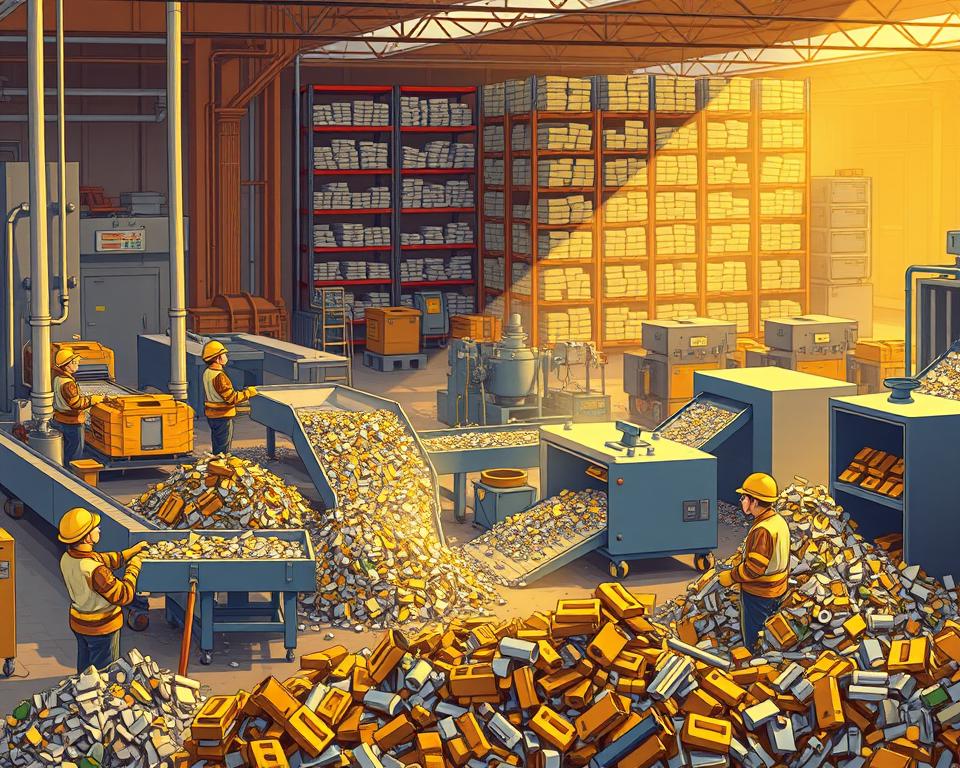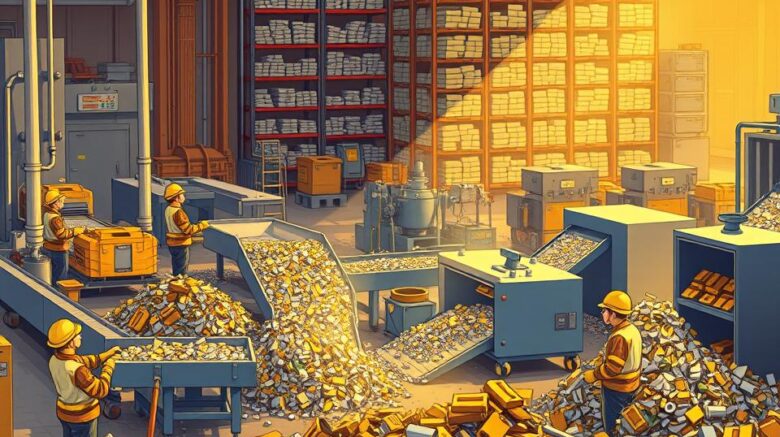Precious Metal Recycling: Your Eco-Friendly Guide
Did you know that more than $60 billion worth of precious metals are discarded each year in electronic waste alone? Such a massive amount highlights why precious metal recycling is so vital. It’s not just good for our economy but also for the environment. Reclaiming gold, silver, platinum, and palladium helps lower pollution and preserve what’s left of our natural resources.
Companies like Dongsheng Metal Trading are leading the charge towards sustainability. They ensure these valuable metals are reused, not dumped in landfills. Such a precious metal recycling model drives eco-friendly recycling and sustainable methods.
Notable Observations
- Each year, e-waste discards over $60 billion in precious metals.
- Recovering these metals cuts eco-impact and preserves resources.
- Valuable metals include gold, silver, platinum, and palladium.
- Eco-friendly recycling practices are vital for sustainable development.
- Companies like Dongsheng Metal Trading specialize in metal recycling.
Exploring Precious Metals and Their Worth
Precious metals are rare, naturally occurring metallic elements that have captured the interest of investors and industries alike. Gold, silver, platinum, and palladium stand out for their distinct qualities. Notable traits are excellent conductivity, corrosion resistance, and rarity. Extracting and refining them uses up huge resources, so recycling becomes critical.

Intrinsic qualities and demand in the marketplace determine precious metals’ worth. Recycling precious metals plays a critical role in sustaining the supply chain. It cuts the environmental toll of mining operations. By thorough recycling, these metals return to their pure form. Such efforts save limited resources and create economic gains.
Precious Metals Explained
Precious metals possess unique characteristics that make them desirable for a variety of applications. Scarcity plus special properties drive their economic importance. For example:
- Gold: Valued for its beauty and resistance to tarnish.
- Ag: Known for flexible uses and excellent conductivity.
- Platinum: Esteemed for its toughness and catalyst role.
- Palladium: Gaining traction in cars and electronics.
Reasons to Recycle Precious Metals
Recycling these metals is now key to sustainable practices. It preserves resources and lessens the environmental cost of mining. Key benefits include:
- Cutting down mining-related environmental harm.
- Lower energy consumption compared to extracting new metals from the earth.
- Supporting a circular economy via material reuse.
- Economic upside from extracting high-value resources.
Why Precious Metal Recycling Matters
Recovering metals delivers big eco and financial wins. Emphasizing benefits helps cut environmental harm. Additionally, it fuels market growth and resilience.
Green Benefits
The environmental benefits of recycling precious metals are significant. When we recover metals from e-waste and scrap, landfill volume drops. That cuts new mining needs and saves resources.
It lessens mining impacts, including ecosystem harm and contaminants. A focus on metal recovery moves us toward real sustainability.
Economic Benefits
Financial perks of recycling are just as strong. Recovering metals cuts production expenses. That shift enables firms to opt for recycled rather than virgin metals.
It produces recycling-sector employment and strengthens markets with growing recycled-metal needs. Harnessing these gains helps firms improve their bottom line. They add to a more sustainable marketplace.
Steps in Metal Recycling
The precious metal recycling process is complex, involving several stages to ensure maximum efficiency. Collection of e-waste, jewelry, and industrial scrap kicks off the process. Next comes sorting, cleaning, and testing to assess metal content and worth.
The Precious Metal Recycling Process
A structured workflow is key to high-yield recovery. All stages focus on boosting metal yield. Metals are sorted according to their type and purity. Decontamination eliminates residues that block recovery. Chemical analysis pinpoints metal levels to drive technique decisions.
Recycling Techniques Used
Cutting-edge processes boost precious-metal recovery. Thermal reduction, using high temperatures to separate metals from ores, is a key method. Molten refining and wet-chemistry steps handle finer separations. Recyclers like Dongsheng Metal Trading employ these approaches to improve yields and returns.
Types of Precious Metals that can be Recycled
Recovery efforts support both ecology and resource reclamation. A host of precious metals are recyclable, aiding markets and ecosystems. Awareness of recyclable metals guides consumers and companies.
Key Precious Metals
Gold, silver, and platinum are well-known precious metals. You’ll see them in rings, currency, and industrial parts. Gold recovery is widespread because of its worth and need. Silver recovery matters too, thanks to its role in imaging, tech, and solar.
Though scarcer, platinum’s worth shines in auto catalysts.
Rare Metals in Electronics
Electronics scrap contains metals ripe for recovery. Devices such as phones and computers hold palladium and indium. These metals are a treasure trove for recycling, reducing e-waste and providing essential materials.
The need to recycle these metals is critical. Industries aim to minimize waste and efficiently recycle resources.
Industries that Benefit from Precious Metal Recycling
Recycling precious metals supports industries by providing efficient, green resource supply. The electronics industry, with its frequent use of precious metals in devices, benefits greatly. Aerospace and healthcare rely on them for vital parts. Looking at their recycling practices shows green and financial gains.
Tech Electronics
Because devices abound with metals, electronics tops recycling efforts. Rapid technological advancements have led to a significant increase in electronic waste. Hence, recovering metals like gold, silver, and palladium is crucial. It not only conserves natural resources but also reduces mining-related carbon emissions.
Businesses enhance recovery to align with green and zero-waste aims. Such a move upholds efforts to conserve and protect.
Aerospace and Medical Equipment
Recycling precious metals matters for aerospace and healthcare, given their reliance on them. High-performance alloys are essential for manufacturing flight parts and medical devices due to their durability and resistance to corrosion. Recovering them cuts costs and meets green regulations.
They recognize that recycling offsets material scarcity. Plus, it boosts efficiency, cementing recycling as a sustainability strategy.
Finding Precious Metal Recycling Companies
Locating reliable recycling partners ensures great results. Be sure to quiz them on their methods. Pricing models and processes make a big difference. Reviewing offerings lets you select wisely.
Key Questions for Recyclers
- Can you share your precious-metal recovery accreditations?
- What techniques do you use for each metal type?
- What yields can you deliver for gold, silver, and more?
- How do you handle pricing, and what additional fees might apply?
- Can you provide references or testimonials from previous clients?
Evaluating Offers
You must evaluate services side-by-side to pick the right recycler. Create a table to compare key factors such as:
| Company Name | Recovery Rate (%) | Processing Fee ($) | Turnaround Time (Days) |
|---|---|---|---|
| Recycling Co. A | 95 | 50 | 7 |
| Recycling Co. B | 90 | 45 | 5 |
| Recycling Co. C | 92 | 55 | 10 |
Comparing options ensures you get top value and service. That way, you maximize returns and maintain quality.
Your Metal Recycling Handbook
Knowing recycler operations matters if you recycle metals. These experts manage the entire process, from collection to processing. That approach drives top efficiency and returns.
Recycler Operations
Recyclers use advanced methods for metal recycling, including testing, separation, and refining. Collection comes from devices, jewelry, and industrial waste. Then, they use sophisticated techniques to separate different metals. Finally, they refine each batch to recover gold, silver, platinum, etc.
That workflow both boosts recovery and promotes green methods. It’s a critical step towards sustainable development.
Finding Your Perfect Recycling Partner
You’ll want to weigh several factors in your choice. Begin by checking their green credentials. Now more than ever, green commitment is crucial. Next, review their service range—from pickup to refining.
Your budget will influence your choice. Request estimates from multiple firms. Experts like Dongsheng Metal Trading provide industry-specific offerings. They stand out as dependable recyclers.
The Role of Metal Recycling Facilities
Recycling centers play a key role in sustainability and waste control. It encompasses various recycling centers, each tailored to specific metal recovery needs. Understanding these facilities improves access to recyclers and their services. This benefits both businesses and the environment.
Recycling Center Types
Metal recycling facilities vary widely in their operations. Certain centers specialize in high-value metals; others take general scrap. Here are a few common types:
- General scrap yards handle both ferrous and non-ferrous materials.
- High-value metal recyclers provide precision recovery for gold, silver, platinum, etc.
- E-waste hubs target valuable metals inside tech devices.
Location and Access to Facilities
Accessibility to recyclers is key for efficient metal recovery. Firms need to plan transport logistics. Here are some factors that influence access:
| Factor | Description |
|---|---|
| Distance | Closer sites cut shipping costs and delays. |
| Networking | Strong ties with local centers streamline recovery. |
| Service Range | Knowing each facility’s offerings guides your choice. |
Ultimately, facility type and access shape recycling success.
Recovering Metals from E-Waste
Discarded electronics threaten the environment. Discarded devices often contain precious metals that can be recovered through recycling. This highlights the importance of seeing e-waste as a valuable resource.
How Electronics Contain Precious Metals
Devices often contain bits of gold, silver, and palladium. These metals are found in various parts:
- Circuit boards
- Connectors and ports
- Capacitors and resistors
- Battery terminals
From phones to TVs, electronics pack precious metals. By recycling, we retrieve and reuse these valuable elements.
The Importance of E-Waste Recycling
E-waste recycling is vital for both environmental protection and resource recovery. It reduces landfill waste and saves natural resources. Key perks include:
- It lowers pollution risks tied to discarded electronics
- It reduces CO₂ output via green recycling methods
- It fuels a circular economy by feeding materials back into manufacturing
Encouraging electronic recycling promotes sustainable resource management. It’s essential for the well-being of future generations.
Future Trends in Metal Recovery
The field of precious metal recycling is undergoing a transformation, driven by technological progress and a surge in sustainability efforts. Facing resource limits, recyclers embrace new methods. Adopting fresh techniques, they’re shaping tomorrow’s recycling.
Eco-Friendly Recycling Innovations
Current trends in sustainable recycling focus on reducing waste and minimizing environmental impact. Firms now use bio-packaging and low-energy methods. That evolution supports global green targets and fosters industry responsibility.
Innovations in Precious Metal Recovery
Advances in recovery techniques are key to improving precious metal recycling efficiency. Automated sorters and hydrometallurgy ramp up yield. They ramp up yields and shrink eco-footprints, advancing metal recycling.
Launching a Metal Recycling Startup
Launching a metal recovery firm requires careful strategy and market insight. Leaders should map out steps, secure compliance, and set firm roots. Key tasks include market studies and pinpointing customer segments. Also, obtaining necessary permits and understanding legal aspects is vital for sustained success.
Launching Steps
To launch your recycling venture, follow these steps:
- Conduct market research to understand needs and rivals.
- Draft a strategy blueprint covering targets and methods.
- Invest in equipment tailored to your process needs.
- Obtain capital via loans or investors.
- Get all required permits and licenses.
- Deploy promotional plans to gain customers.
Compliance and Certifications
Understanding legal aspects when starting a precious metal recycling business is critical. Complying with eco-regulations keeps your business green and lawful. Key considerations include:
- Securing business certification from relevant authorities.
- Following all levels of waste and recycling regulations.
- Ensuring all employees are trained on safety protocols and procedures.
In Closing
Recycling metals saves resources and boosts ecological well-being. It empowers all of us to reduce environmental harm from waste. That reclaimed metal cuts mining demand and spawns recycling jobs.
Beyond green gains, recycling yields financial perks. Partnering with companies like Dongsheng Metal Trading ensures a commitment to eco-friendly practices. Such alliances reinforce the circular economy for all stakeholders.
Our path to sustainability relies on united metal recovery initiatives. Growing awareness can lead to a society that values responsible consumption and environmental care. Implementing these measures supports us today and safeguards future generations.
